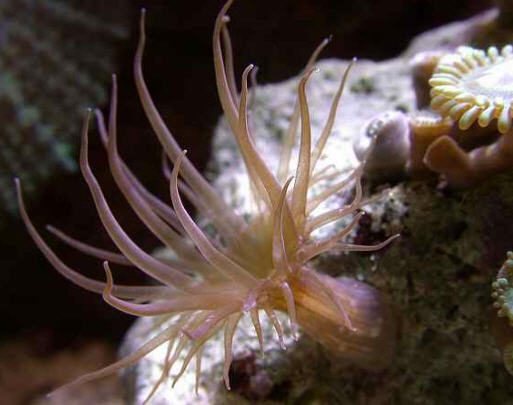Saltwater ich, also known as marine ich or Cryptocaryon irritans, is a parasitic infection that commonly affects saltwater fish. The disease is caused by a protozoan parasite that attaches itself to the fish’s skin and gills, causing white spots or patches. As the disease progresses, the fish may exhibit additional symptoms such as loss of appetite, rapid breathing, and scratching against surfaces. If left untreated, saltwater ich can be fatal for fish. Therefore, it is essential to recognize the signs and symptoms of this disease and take appropriate measures to prevent and treat it.
How to identify ICH
Ich are small creatures that burrow into the skin of your fish. When they burrow you will see little bumps or white spots. Those white spots are scabs covering over their entrance. Ich can also be confused with velvet. The rule of thumb is that if you can count the spots, it’s ich, if it is a white fuzz of spots, it’s velvet.
Why is ich so bad?
Ich is one of the most dreaded saltwater parasites. It’s lifecycle, difficulty to remove it and mortality rate make it a terrible pest.
Ich has a lifecycle that makes it very difficult to cure. As it feeds on a fish it releases tomonts that attach to anything it can, it then reproduces and trophonts are released that attach to fish and start the cycle again. So even as you cure the fish it can continually get reinfected over and over.
Ich attacks the gills especially aggressively and ends up suffocating the fish to death.
Eradication vs Control
There are two trains of thought and options with ich. Complete eradication of the animal, or controlling it in the tank.
Eradication is not easy. If you have a fowlr tank (fish only with live rock), it isn’t too difficult. But if you have coral or inverts, then it is extremely difficult. With a fowlr tank you can run a liquid copper in the tank which kills the ich without harming the fish, in a reef tank you have no such options.
Control is another option. Even if you run a ich free tank completely, every new fish, snail or coral could introduce the ich tomont (larve). It is very difficult without a religious quarantine protocol to run a tank like this. While it is difficult, it is by far the best option if possible.
FOWLR Tank
If you see ich in a fowlr tank, it isn’t fun, but is much simpler than people who have coral or inverts. Chelated copper is the go to cure for ich in these tanks. Copper is deadly to ich and while it’s not healthy long term for fish, it will not harm them in the short term.
First step is to make sure you have Chelated copper and a copper tester, or access to testing equipment. The therapeutic range for chelated copper is 1.5 – 2.0 ppm for 14 days. This is very important, lower than that and you aren’t at theraputic levels and you will not kill the ich. Above that and you get into dangerous territory for your fish, especially some of your more sensitive fish like wrasses.
It is important to start copper immediately because you need to ramp up slowly as to not affect your fish. If you start too late, the low level of copper may not be enough to help your fish in time.
We highly recommend you remove copper after your done dosing your tank for the health of your fish. There are copper absorbing medias like cuppersorb, polyfill pads and triton detox that will remove it.
Reef Tank
Having coral or other inverts like snails and shrimps, make an ich outbreak much more serious and deadly. Copper is not just poisonous to coral and invertebrate animals, it has a tendency to leech out of rocks, sand and plastic for years afterwards continually poisoning your tank.
With copper not being an option, there are a few choices. Chemicals that claim to cure ich in a reef tank, quarantine combined with a fallow period, and more excitingly hydrogen peroxide.
There are some chemicals that claim to be reef safe and to cure ich. If they work, they are very limited. It’s a joke in the industry, that if someone could cure ich in reef tanks with a chemical, they would be very rich… very fast. That is because it is one of the main frustrations that people have, and one of the main reasons people get out of the hobby after a heartbreak. We wish we could recommend a specific one, but there is no evidence that there is anything substancial happening with any of them.
Because of the lifecycle of ich, the trophonts have to find a fish to continue the cycle. If you can keep your tank empty of fish long enough, they all die off. This is called fallow. You basically need to quarantine your fish in a secondary tank(s), and medicate them with copper as in the fowlr tank above. While that is happening you allow your main tank to remain fallow without any fish what-so-ever, for 6 weeks. This combo basically kills all of the ich on your fish and in your tank. This is very effective but a bit complicated.
Hydrogen Peroxide
Hydrogen peroxide has been found to be effective in treating various parasites, including ich, velvet, and flukes in reef tanks. When dosed correctly, hydrogen peroxide can kill parasites without harming your fish or other aquatic animals. The process of dosing hydrogen peroxide involves adding small amounts of it to your tank over a period of time, usually several days, until the desired concentration is reached. This is the article that this information is taken from, we HIGHLY recommend you read this entire article.
https://humble.fish/community/index.php?threads/peroxide-h2o2-dosing-for-parasites-in-reef-tank.725/
To avoid harming your aquatic animals, it is crucial to administer hydrogen peroxide correctly. The recommended dosage for hydrogen peroxide is 1 ml per 10 gallons of tank water, which can be adjusted depending on the type of parasite and the severity of the infestation. However, it is important to monitor the oxygen levels in your tank, as hydrogen peroxide can deplete oxygen levels and harm your fish.
Before adding hydrogen peroxide to your tank, dilute it in a small amount of tank water and add it slowly while closely monitoring your tank’s parameters. It is also important to take precautions such as monitoring oxygen levels, pH levels, and temperature, and using a quarantine tank to treat infected fish.
If dosed correctly, hydrogen peroxide can effectively treat parasites in reef tanks, but keep in mind this is experimental for now
Preventing Ich
Preventing Ich from infecting your fish in the first place is the best approach to take. Here are some tips to help reduce the risk of Ich in your aquarium:
- Quarantine any new fish for at least two weeks before introducing them to the main tank.
- Maintain good water quality by performing regular water changes and using a reliable filtration system.
- Avoid overfeeding your fish, which can lead to an increase in organic waste and poor water quality.
- Keep stress to a minimum by providing your fish with a suitable environment, including adequate hiding places, appropriate water temperature, good food, ethical stocking and lighting.




